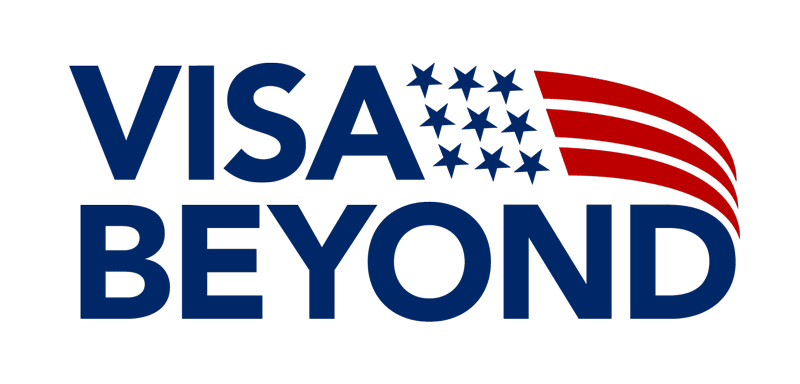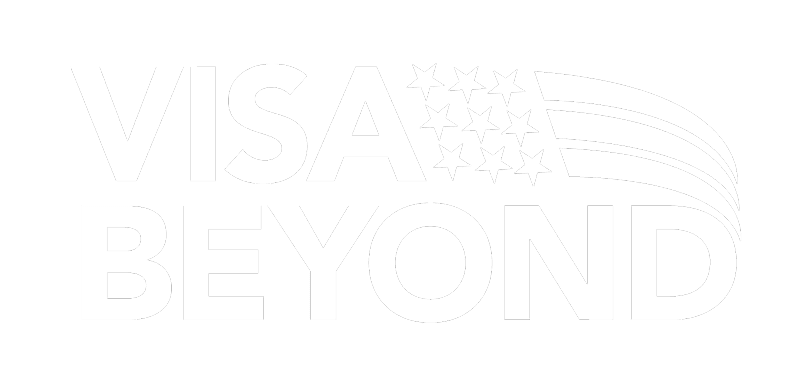EB-1 Visa:
A Pathway to
U.S. Residency.
The EB-1 visa provides a fast track to U.S. green card for those with extraordinary abilities, offering priority processing for top professionals.
The EB-1 visa is a high-preference green card option, allowing outstanding individuals to skip the labor certification process and speed up their path to U.S. permanent residency.
Self-Apply
Apply independently
without sponsorship.
Speedy Processing
Prioritized for
fast approval.
Family Access
Your spouse and children under
21 can get green cards too.
Fast Green Card
Quick path to
U.S. residency.
No Job Proof
No employer
certification needed.
Client
Satisfaction
Years
in the business
EB-1 Visa:
Key Benefits and Overview
The EB-1 visa, often referred to as the “first preference” employment-based visa, offers a fast track to U.S. residency for individuals with extraordinary abilities, outstanding professors and researchers, and multinational executives or managers. This visa is a highly desirable option due to its shorter processing times and the absence of a labor certification requirement.
What is the EB-1 Visa?
The EB-1 visa is an employment-based visa that allows foreign nationals with exceptional qualifications to gain permanent residency in the United States. It is divided into three subcategories:
- EB-1A: Individuals with extraordinary ability in their field.
- EB-1B: Outstanding professors and researchers.
- EB-1C: Multinational executives and managers.
This visa category is designed to attract top talent to the U.S. and offers an expedited path to permanent residency.
EB-1 Visa Eligibility: Who Can Apply?
Eligibility for the EB-1 visa depends on the specific subcategory:
- EB-1A: Must demonstrate extraordinary ability through sustained national or international acclaim.
- EB-1B: Requires proof of being an outstanding professor or researcher with a minimum of three years of experience.
- EB-1C: Must be a multinational executive or manager employed by a qualifying organization.
Applicants must meet stringent criteria, which often involve extensive documentation and evidence of their achievements.
EB-1 Visa Success Rate.
The EB-1 visa approval rate is relatively high, with variations depending on the specific sub-category.
00%
Depending on
EB-1 Sub-categories
EB1 Visa Application Costs and Processing Timeline
An overview of fees and processing times for applying to the EB1 Visa program for individuals with extraordinary abilities.
Application Fees
- Form I-140 Filing Fee: $700
- Form I-485 Filing Fee: $1,140
- Biometrics Fee: $85
- Visa Issuance Fee: Varies by country
- Premium Processing Fee: $2,500
Application Timeline
- Standard Processing Time: 2 to 6 months, depending on the service center.
- Expedited Processing: 15 days with a $2,500 premium processing fee.
FAQs
About EB-1 Visa.
Is EB-1 Visa Better Than H-1B?
EB-1 visa and H-1B visa serve different purposes, but the EB-1 visa is often considered more advantageous for eligible individuals. Unlike the H-1B, the EB-1 is a direct pathway to a green card and permanent residency in the U.S. The EB-1A also allows for self-petitioning, meaning no employer sponsorship is required, unlike the H-1B, which mandates employer sponsorship and is subject to annual caps. Additionally, the EB-1 category does not require a labor certification, speeding up the application process compared to H-1B holders who need to go through the employer petition and possibly a labor certification for permanent residency later.
When is USCIS EB-1 Visa Number Cap Renewal?
The USCIS renews the EB-1 visa number cap at the beginning of each fiscal year, which starts on October 1st. The number of visas available for EB-1 applicants is limited annually, and if the cap is reached, applicants may have to wait for the next fiscal year for their priority date to become current.
How Many Citations are Needed for EB-1?
There is no strict minimum number of citations required for the EB-1A visa, but the more citations, the stronger your case for extraordinary ability. Typically, having a significant number of citations (usually 100+ for science-related fields) can support your petition, but quality matters as much as quantity. USCIS evaluates your contributions based on the impact and recognition of your work, not just the number of citations.
Can You File EB-1 Concurrently?
Yes, you can file the EB-1 visa petition concurrently with your Form I-485 (Adjustment of Status), provided a visa number is immediately available for your priority date. This is known as concurrent filing, and it allows you to submit both the I-140 and I-485 forms simultaneously. Concurrent filing speeds up the process for obtaining a green card, as you don't have to wait for the I-140 approval before filing the adjustment application.
Can My Family Join Me on an EB-1 Visa?
Yes, your family can join you on an EB-1 visa. Your spouse and unmarried children under 21 can apply for derivative visas based on your EB-1 status. They will receive E-14 or E-15 visas, depending on the specific EB-1 category you qualify under. Upon your green card approval, they can also adjust their status to become permanent residents.
Clients we
work for.
















EB-1A vs. EB-1B vs. EB-1C : Which Category is Right for You?
Understanding which EB-1 subcategory suits your profile is essential. Below is a comparison chart to help determine which category fits your qualifications:
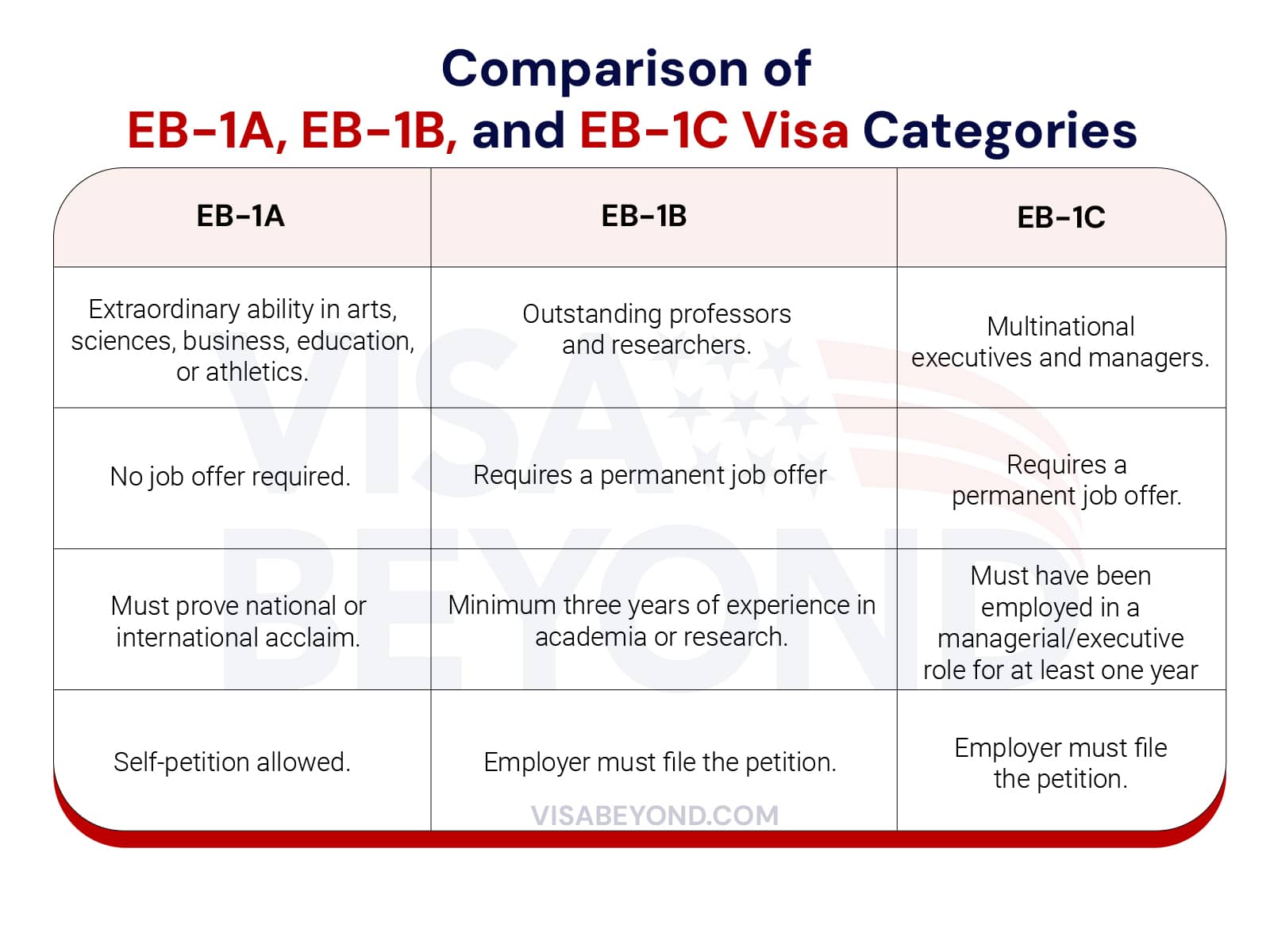
EB-1 Visa Requirements: Essential Criteria for Applicants and Employers
Both applicants and employers must meet certain requirements to qualify for an EB-1 visa. Understanding these criteria can streamline the application process and increase the chances of approval.
Who Qualifies for EB-1A Visa?
To qualify for the EB-1A visa, applicants must show extraordinary ability in their field with national or international recognition. Key qualifications include receiving major awards, such as industry-specific honors or notable recognition. Applicants can also demonstrate eligibility through memberships in organizations that require outstanding achievements, having published work in professional journals, or by judging the work of others in their field. Other qualifications include making original contributions that have had a major impact in the industry and earning a high salary that reflects exceptional ability.
Who is Eligible for EB-1B Visa?
To be eligible for the EB-1B visa, applicants must meet the following criteria: they must be an outstanding professor or researcher, recognized internationally in their field. Additionally, they need at least three years of experience in teaching or research. Lastly, applicants must have a permanent job offer from a U.S. institution of higher education or a private employer with a strong record of research achievements. To support their application, candidates should provide evidence such as publications, awards, or memberships in exclusive academic organizations.
EB-1C Visa for Multinational Executives and Managers
The EB-1C visa is tailored for multinational executives and managers who meet specific eligibility criteria. To qualify, the applicant must have been employed in a managerial or executive role for at least one year by a multinational company. Additionally, they must be seeking entry to the U.S. to continue working in a similar capacity for the U.S. affiliate of their foreign company. The U.S. company must have a qualifying relationship with the foreign company, such as being a parent, branch, subsidiary, or affiliate. This visa is ideal for executives and managers being transferred to the U.S. to work in their company’s American offices, providing a streamlined pathway to permanent residency.
Employer Requirements for Sponsoring an EB-1 Visa
Employers sponsoring an EB-1 visa must:
- Provide a Permanent Job Offer: For EB-1B and EB-1C categories.
- Support the Petition: By providing evidence that the applicant meets all eligibility requirements.
- Submit Required Documentation: Including proof of a qualifying relationship for EB-1C applicants, and evidence of significant research achievements for EB-1B.
How to Apply for the EB-1 Visa: Step-by-Step Process
To apply for an EB-1 visa, first determine your eligibility under the EB-1A, EB-1B, or EB-1C category. Then, file Form I-140 with USCIS, including documentation of your achievements, such as awards, publications, or an employment offer. After paying the fees, await USCIS approval. Once approved, you can adjust your status to permanent residency or proceed with consular processing if abroad. Accurate and complete documentation is crucial for success.
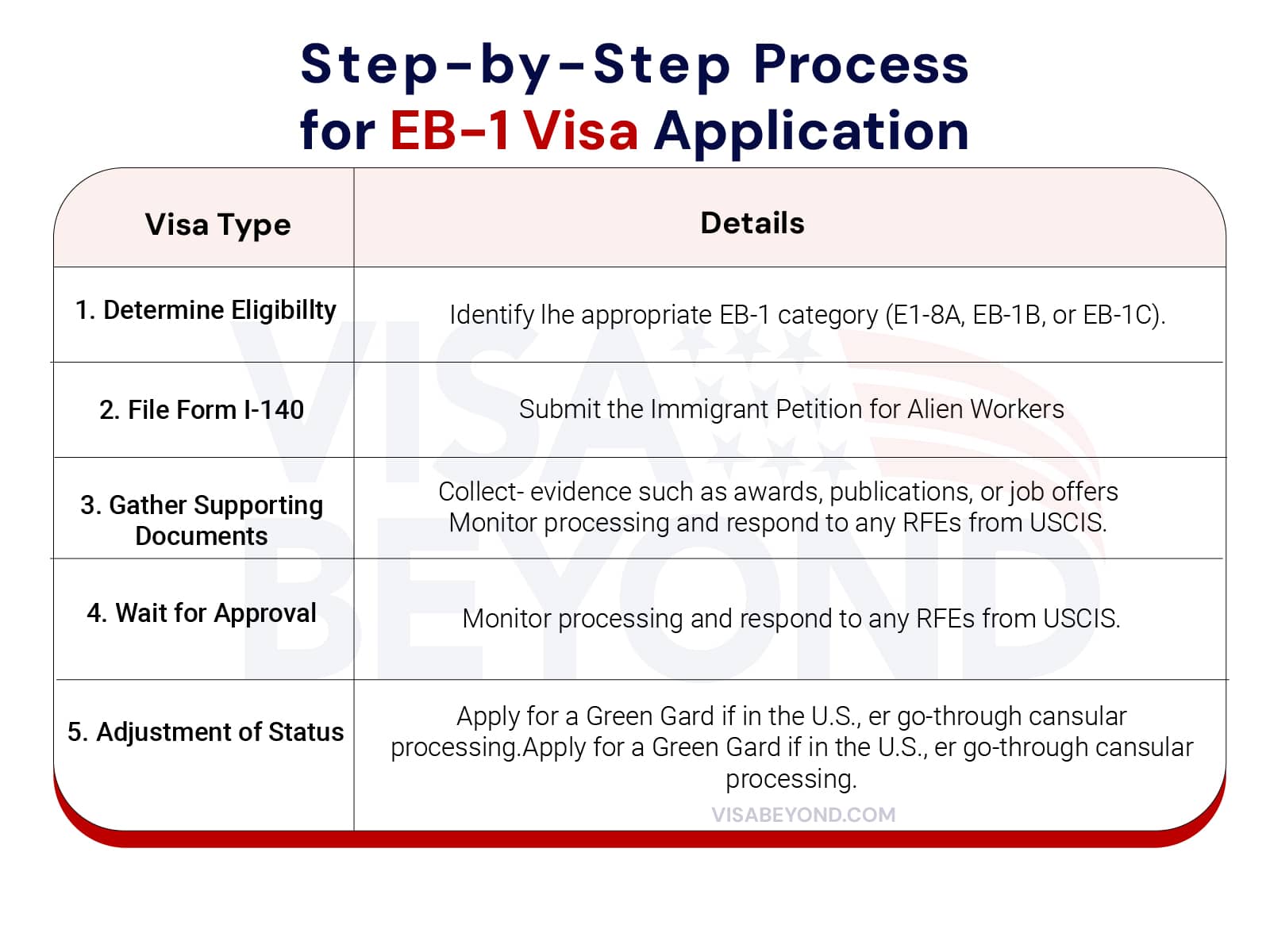
Filing Form I-140: Immigrant Petition for Alien Workers
Form I-140 is the primary form used to petition for the EB-1 Visa. Here’s what you need to know:
- Purpose: To establish eligibility for the EB-1 visa based on extraordinary ability, outstanding achievement, or a qualifying executive/managerial role.
- Who Files: The employer typically files this form, except for the EB-1A category, where the individual can self-petition.
- Key Sections: Include details about the beneficiary, evidence of qualifications, and information about the sponsoring employer (if applicable).
How to Write a Winning EB-1 Visa Recommendation Letter
A well-crafted recommendation letter can significantly impact your EB-1 Visa petition. Follow these tips:
- Highlight Specific Achievements: Focus on extraordinary abilities or contributions.
- Use Reputable Sources: Letters should come from recognized experts in your field.
- Be Detailed: Include specific examples of how the applicant has made significant contributions to their field.
- Use a Professional Tone: Keep the letter formal and focus on facts and evidence, avoiding overly emotional language.
- Emphasize Impact: Highlight the broader impact of the applicant’s contributions, like industry advancements or widespread adoption of their work.
- Provide Multiple Letters: Include letters from different experts, each focusing on various aspects of the applicant’s qualifications.
How Long Does It Take to Get an EB-1 Visa?
The time it takes to get an EB-1 visa can vary depending on several factors, including the service center processing your application and whether you opt for standard or premium processing. According to USCIS, processing times for the EB-1 visa can range from a few months to over a year. Premium processing is available to expedite the process.
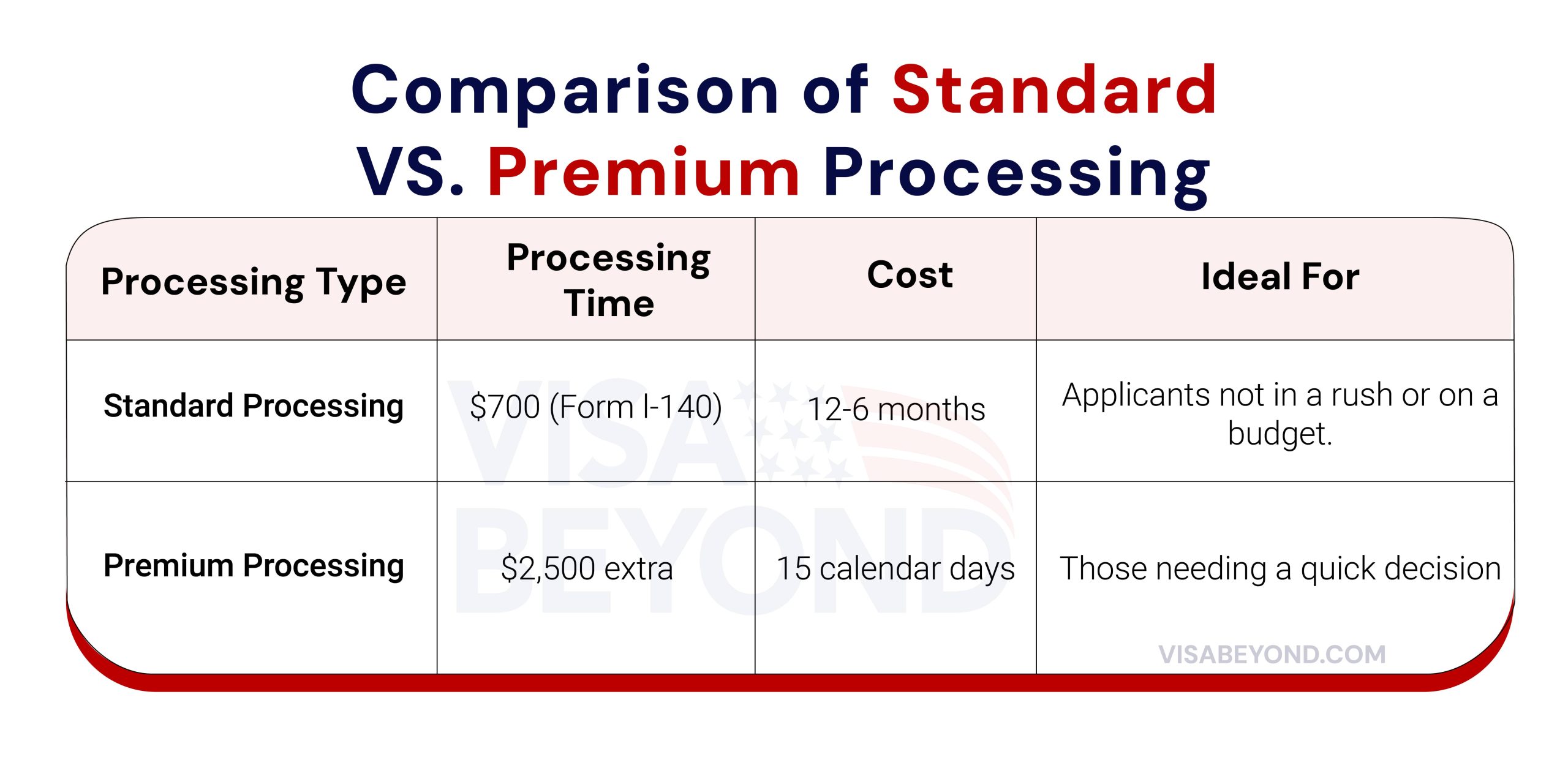
EB-1 Visa Validity, Extensions, and Renewals
The EB-1 visa is initially valid for an indefinite period, leading directly to a green card without the need for periodic renewals like nonimmigrant visas. However, understanding the nuances of visa validity, extensions, and renewals is crucial for maintaining your status. If you’re an EB-1C visa holder for multinational executives or managers, it’s important to ensure that your employment remains in line with your original petition to maintain eligibility. For other EB-1 categories, while the visa itself doesn’t require renewal, staying informed about changes in your situation that could affect your permanent residency is key. The EB-1 visa’s path to a green card makes it a highly desirable option for those with extraordinary abilities or international acclaim.
How Long is an EB-1 Visa Valid For? Understanding Initial Stay and Extensions
Upon approval, the EB-1 Visa grants:
- Permanent Residency: Provides indefinite validity as long as conditions are met.
- Extensions: Not applicable as the visa leads directly to a Green Card.
Renewing Your EB-1 Visa: What You Need to Know
While the EB-1 Visa does not require renewal, maintaining your Green Card status is essential:
- Conditions: Maintain continuous residence in the U.S. and avoid actions that could jeopardize your status.
- Re-entry Permit: For extended travel abroad, apply for a re-entry permit to maintain your status.
Key Deadlines and Procedures for EB-1 Visa Renewal
To maintain permanent residency:
- Green Card Renewal: Required every 10 years, though this is more a replacement of the physical card than a visa renewal.
- Re-entry Permit: If planning to stay outside the U.S. for more than a year, apply for a re-entry permit.
Maximizing Your Stay: How to Maintain EB-1 Visa Status
To make the most of your EB-1 visa stay, it's important to keep things simple and straightforward. Stay in the job that got you the visa, especially if you’re an executive or manager under the EB-1C category. Keep USCIS updated with any big changes, like switching employers or moving to a new location. Avoid long trips outside the U.S. to maintain your residency status.
Form I-129 Checklist: Required Documents and Information
When filing Form I-129, make sure to include the following key documents:
EB-1 Visa Employment and Change of Status
Looking to switch gears while on an EB-1 visa? The EB-1 visa offers flexibility, but it’s crucial to follow the correct procedures. Let’s explore how employment changes impact your visa status and what it means to transition to a new visa category. According to the USCIS, staying compliant with visa regulations is key to maintaining your eligibility.
Changing Employers on an EB-1 Visa: Rules and Procedures
When changing employers on an EB-1 visa, you need to understand specific guidelines to avoid jeopardizing your status. The rules differ based on the type of EB-1 visa you hold:
- EB-1A: Freedom to change employers without requiring a new petition.
- EB-1B: Must file a new I-140 petition when changing employers.
- EB-1C: Employer-specific; changing employers is more complex and may require additional steps.
How to Change Employers on an EB-1 Visa: Filing a New Petition
If you’re an EB-1A visa holder, you can change employers freely without the need to file a new petition. However, if you’re on an EB-1B or EB-1C visa, the process is more complex and requires filing a new I-140 petition. Specifically, EB-1B holders must submit this petition when changing employers, as the visa is tied to the employer’s sponsorship. Similarly, EB-1C visa holders face more detailed procedures since the visa is employer-specific, making the transition to a new employer more complicated. Each visa type comes with its own set of rules that must be followed to maintain legal status.
Documents Needed for a New EB-1 Employer Petition
Getting organized for your new petition is critical. Here’s a checklist of the essential documents:
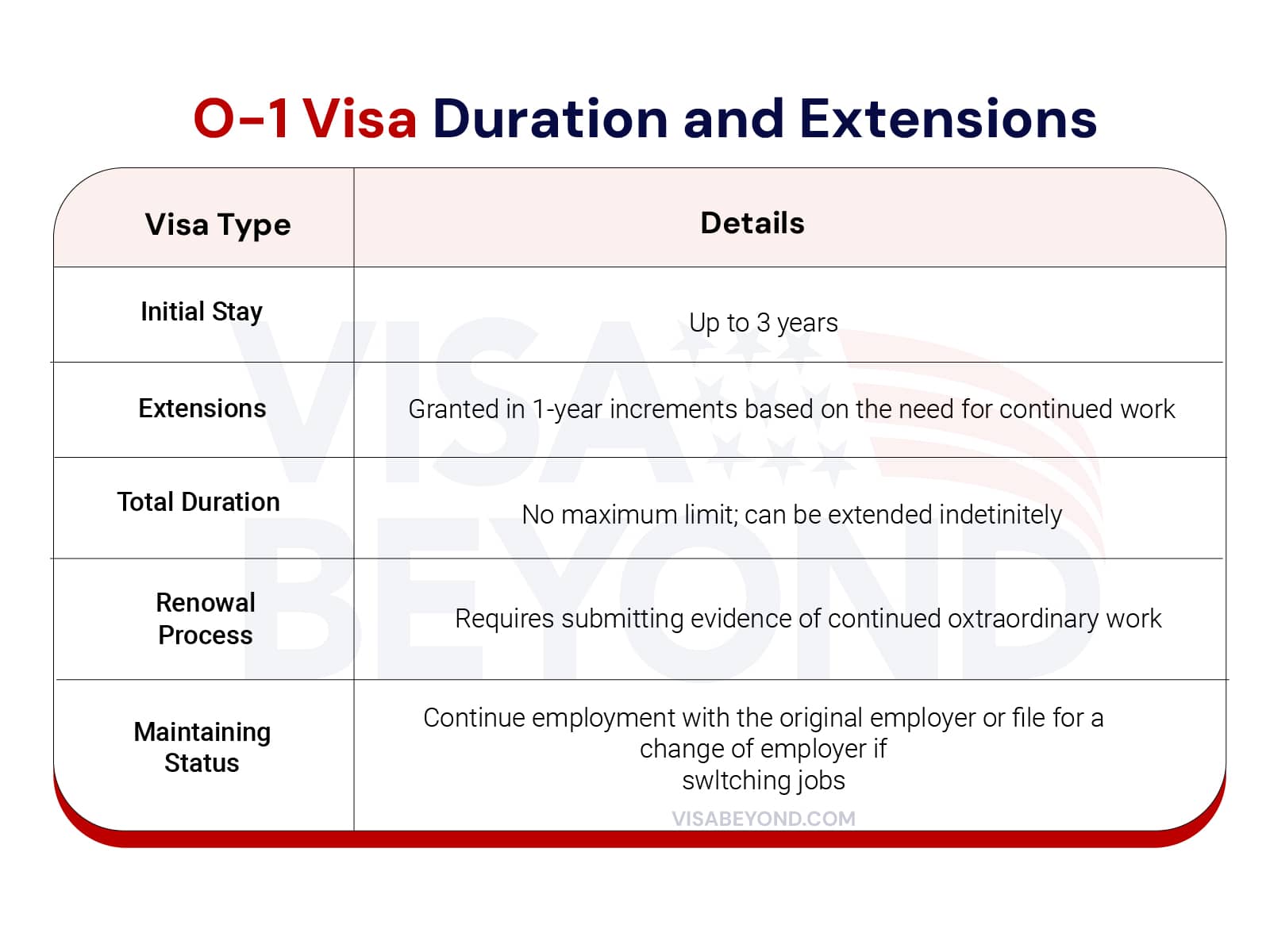
Can You Apply for a Green Card While on an EB-1 Visa?
Yes! In fact, many EB-1 visa holders choose to pursue a green card through adjustment of status (Form I-485) or consular processing if they are outside the U.S.
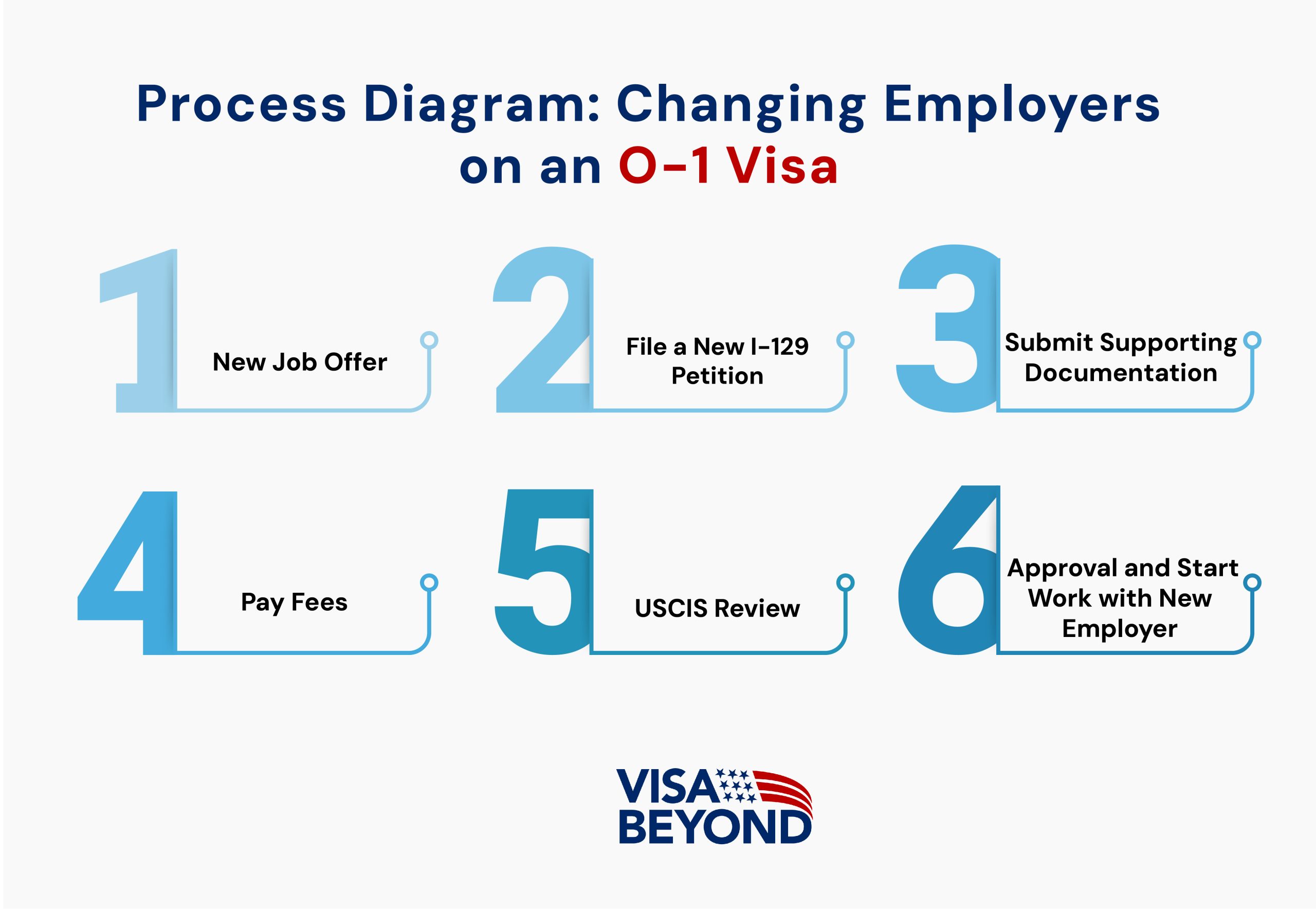
EB-1 Visa Denials, RFEs, and Appeals: Overcoming Challenges
Denied? Received an RFE (Request for Evidence)? Don’t panic. You can still overcome challenges with the right strategy and by understanding common pitfalls.
Why Was My EB-1 Visa Denied? Common Reasons and How to Avoid Them
Some of the most common reasons for EB-1 visa denials include:
Lack of sufficient evidence of extraordinary ability:
- Make sure to showcase your awards, publications, and media coverage.
Failure to meet the eligibility criteria:
Confirm that you qualify under the appropriate EB-1 category.
Common Pitfalls in EB-1 Visa Applications: How to Overcome Them
When applying for an EB-1 visa, even small errors can delay or derail your petition. Here’s how to avoid common mistakes and strengthen your application:
Incomplete Documentation
One of the most frequent reasons for EB-1 visa denials is incomplete documentation. To avoid this, carefully review the USCIS checklist and ensure that all necessary forms, such as Form I-140, and supporting documents are submitted. Missing essential documents, like proof of your extraordinary ability or a job offer for certain EB-1 categories, can lead to delays or rejections. It’s critical to include every piece of evidence, from employment verification letters to academic credentials. Double-check your submission to avoid unnecessary Requests for Evidence (RFEs).
Weak Evidence of Extraordinary Ability
The core of a successful EB-1 application lies in demonstrating extraordinary ability. Simply listing qualifications isn’t enough—you need to provide strong, verifiable evidence. It’s important to go beyond vague descriptions and provide concrete examples that clearly showcase your exceptional contributions to your field. Letters of recommendation should come from well-respected figures in your industry who can attest to your skills and influence. The more thorough and credible your evidence, the better your chances of approval.
Responding to an RFE (Request for Evidence) on Your EB-1 Visa
If you receive an RFE for your EB-1 visa application, don’t panic. USCIS often issues RFEs when there’s missing or insufficient evidence.This is your chance to provide additional evidence or clarify details. Carefully review the request, gather strong supporting documents, and respond within the given timeframe to keep your petition on track. A timely, thorough response can make the difference between approval and denial.
Strategies for Addressing an EB-1 Visa RFE Effectively
- Read the RFE Carefully: Understand what additional information is needed.
- Gather Strong Evidence: Strengthen weak areas.
- Meet the Deadline: Always respond within the timeline given by USCIS.
How to Appeal an EB-1 Visa Denial: Your Legal Options
If your EB-1 visa is denied, you can file a motion to challenge the decision. A Motion to Reopen or a Motion to Reconsider gives you the opportunity to have your EB-1 visa case reviewed again. These motions allow you to address missing evidence or legal errors that may have impacted the original decision. Filing a well-supported motion is crucial for improving your chances of a successful EB-1 visa appeal.
Filing a Motion to Reopen or Reconsider an EB-1 Visa Petition
Motion to Reopen: Submit new evidence that wasn’t initially available.
Motion to Reconsider: Argue that USCIS made an error based on existing evidence.
When responding to an RFE for your EB-1 visa, timing and content are key. Submit your response well before the deadline (usually 87-90 days) to avoid delays. Carefully review the RFE and address each point with strong, relevant evidence, such as publications or expert recommendations. Consider seeking legal help for a well-structured, complete response. Ensure your submission is organized and meets USCIS formatting requirements, like certified translations if needed. By being timely, detailed, and professional, you’ll greatly improve your chances of a successful outcome.
Understanding the AAO (Administrative Appeals Office) Process for EB-1 Visa
The Administrative Appeals Office (AAO) handles appeals for EB-1 visa denials through a structured process. To initiate an appeal, you must file Form I-290B with the AAO. After filing, the AAO reviews all submitted evidence, including the original decision made by USCIS. Based on this review, the AAO will either grant the appeal, reversing the denial, or uphold the original decision, meaning the visa remains denied. This process offers applicants a chance to challenge and potentially overturn USCIS’s decision, but the outcome ultimately depends on the strength of the evidence and legal arguments presented.
Let’s Make Your U.S. Dreams a Reality.
What to Do If Your EB-1 Visa is Denied: Alternative Options
If your EB-1 visa is denied, don’t lose hope—there are several alternative paths you can pursue to still achieve your U.S. immigration goals. Here are some options to consider:
File a New EB-1 Petition:
You can reapply by submitting a stronger EB-1 petition. Take the time to address the reasons for the initial denial, gather additional evidence, and reinforce your case with more detailed documentation, such as stronger letters of recommendation, publications, or industry awards.
Consider Other Visa Categories:
If the EB-1 visa doesn’t work out, explore other visa options like the O-1 visa, which is also for individuals with extraordinary ability, but often has less stringent requirements. Additionally, the H-1B visa is an option for those working in specialty occupations and may offer a more accessible pathway if you have employer sponsorship.
Apply for a Different Employment-Based Visa:
If your EB-1 application didn’t succeed, you may still qualify for other employment-based visas, such as the EB-2 for individuals with advanced degrees or exceptional ability, or the EB-3 for skilled workers and professionals. While these may require labor certification, they can still lead to permanent residency.
Evaluate Temporary Work Visas:
If you're not ready to reapply for another EB-1, you can look into temporary work visas, such as the L-1 visa for intracompany transfers, which might be a good fit if you're a multinational executive or manager.
EB-1 Visa to Green Card: Pathway to U.S. Permanent Residency
The EB-1 visa offers one of the fastest pathways to U.S. permanent residency. If you’re recognized for extraordinary ability or achievements in your field, the EB-1 can lead directly to a green card without needing employer sponsorship in some cases. Whether you apply through Form I-485 (Adjustment of Status) or via consular processing abroad, this visa is a popular choice for high achievers. According to USCIS, one of the major advantages of the EB-1 visa is the streamlined process, often with faster timelines compared to other employment-based green cards.
Dual Intent and the EB-1 Visa: Navigating the Green Card Process
A major advantage of the EB-1 visa is its allowance for dual intent. This means you can pursue a green card while holding EB-1 non-immigrant status without risking visa denial. According to USCIS, this dual intent feature is especially useful, as you can remain in the U.S. while your green card application is processed. You can keep working under your EB-1 status while simultaneously transitioning to permanent residency, making the process much more flexible compared to other visa categories
How to Maintain EB-1 Visa Status While Pursuing a Green Card
Maintaining your EB-1 visa status during the green card process is essential. Here are some key actions to keep in mind:
- Continue Working in Your Field: If you’re on an EB-1A, continue demonstrating your extraordinary ability. For EB-1B and EB-1C holders, stay employed with your sponsoring employer.
- Renew Your Visa: Ensure your visa is valid throughout the green card process, especially if the I-485 takes time.
- Respond to USCIS: Any Requests for Evidence (RFEs) must be addressed promptly to avoid delays.
EB-1 Visa vs. Other Employment-Based Green Cards: Differences and Advantages
The EB-1 visa has several advantages compared to other employment-based green cards such as EB-2 and EB-3. One of the biggest benefits, according to USCIS, is the no labor certification requirement, saving months of processing time. EB-1 applicants often enjoy shorter wait times for their green card, especially when priority dates are current. Additionally, the EB-1A allows for self-petitioning, giving applicants more flexibility.
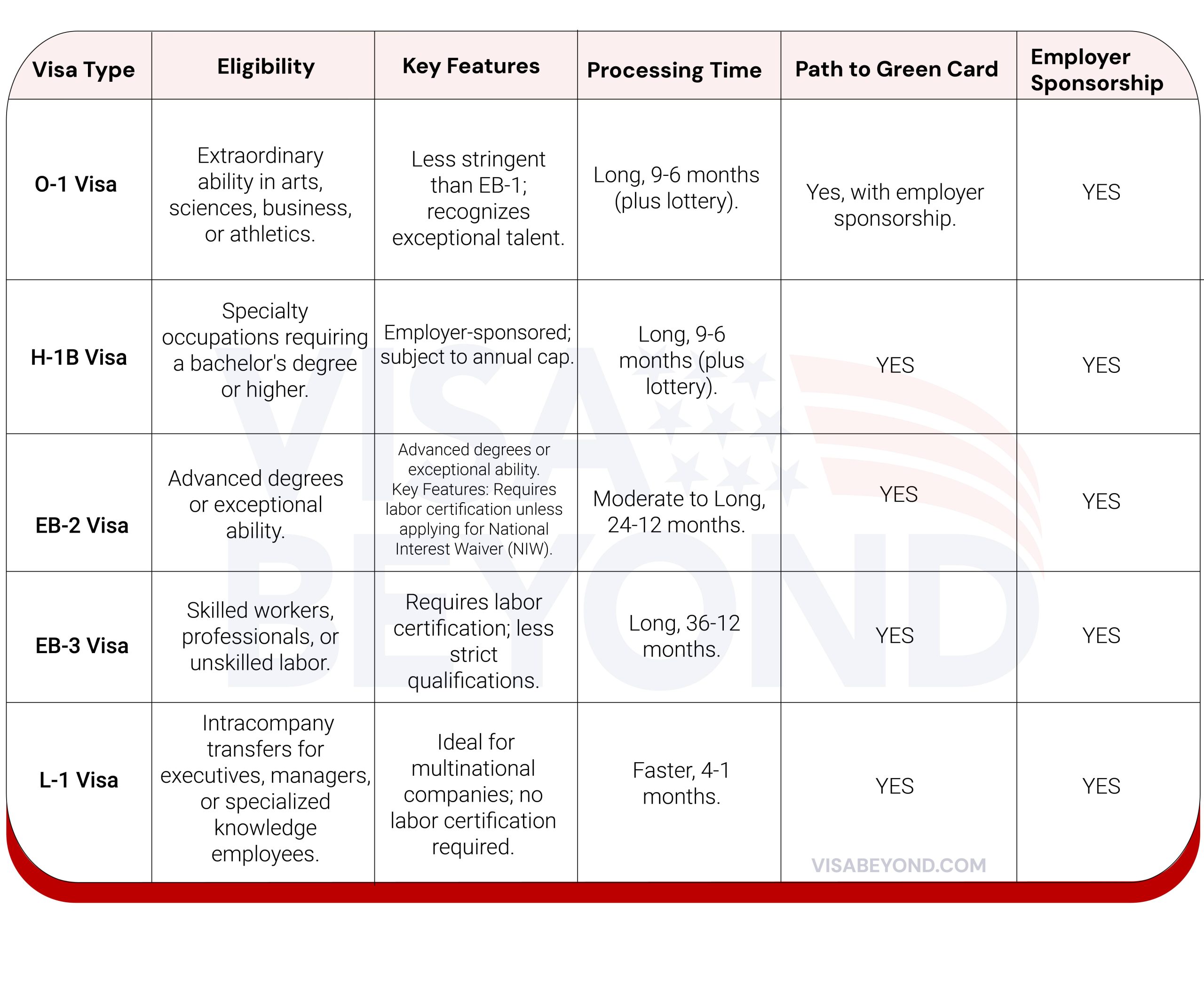
Why the EB-1 Visa is the Best Choice for Exceptional Individuals
Choosing the EB-1 visa is a strategic move for those who qualify, as it offers a faster and more straightforward route to U.S. permanent residency. With no need for labor certification and the opportunity to bypass many of the hurdles faced in other visa categories, the EB-1 visa is ideal for individuals who have demonstrated extraordinary abilities. If you meet the eligibility requirements, this visa opens doors to unparalleled professional and personal opportunities in the United States, making it a wise choice for exceptional achievers.
Latest News.
From the blog

-
- Posted by Alvez
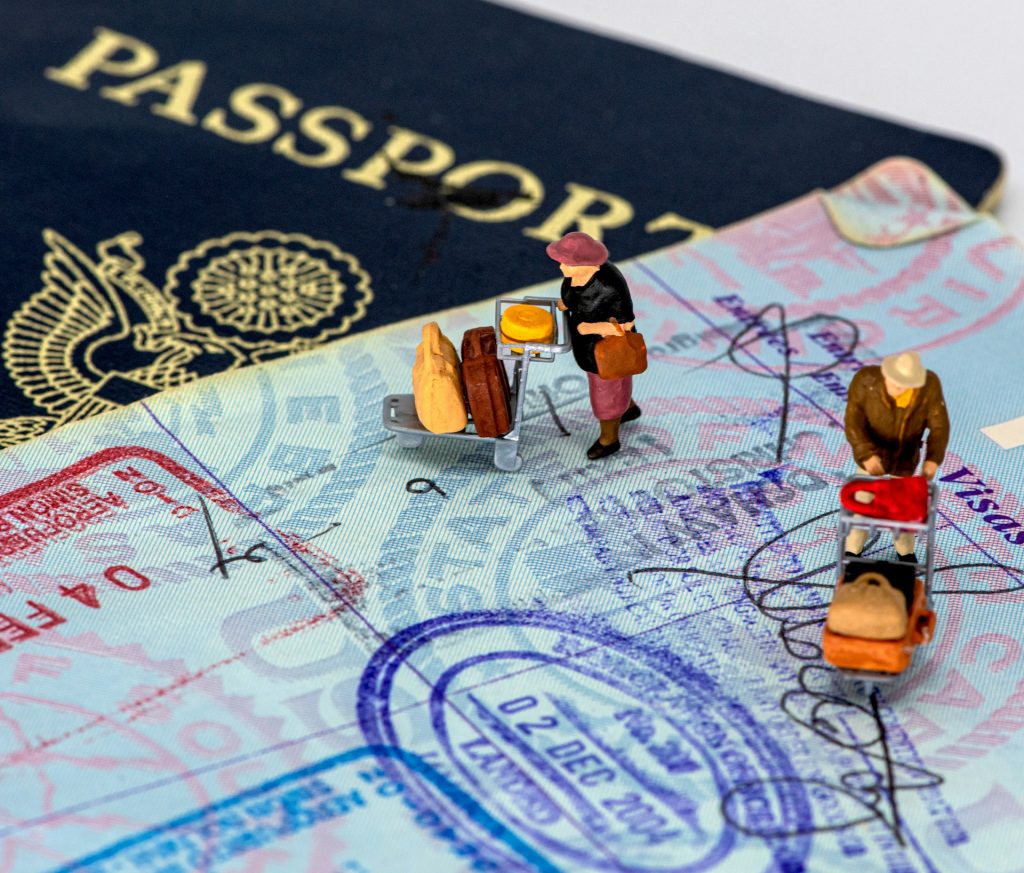
-
- Posted by Alvez

-
- Posted by Alvez
"*" indicates required fields
